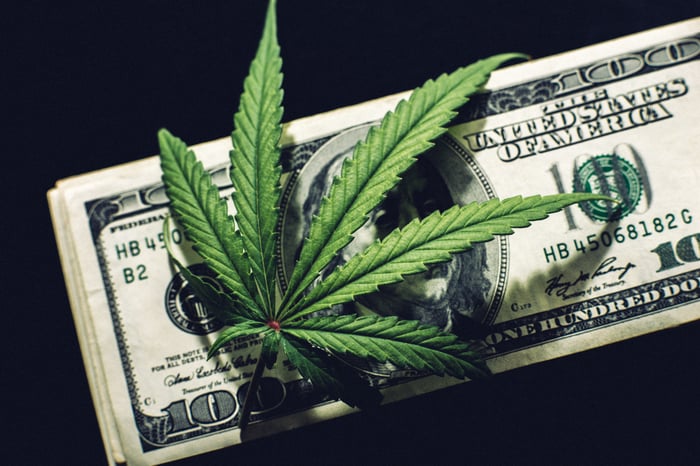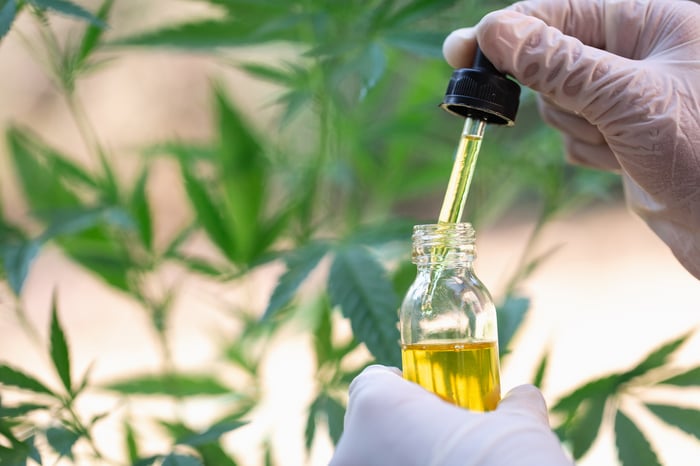The big day is nearly here, at least for cannabis investors. On Thursday morning, Aug. 15, Canopy Growth (CGC -3.13%), the largest marijuana stock in the world by market cap, will report its first-quarter operating results for fiscal 2020.
According to the 10 Wall Street analysts currently offering quarterly estimates, Canopy's consensus is for 109.2 million Canadian dollars in gross sales (ranging from a low of CA$96.8 million to a high of CA$124.7 million), and a net loss of CA$0.38 per share. For what it's worth, Canopy Growth's net loss has more than doubled Wall Street's consensus loss estimate in each of the past four quarters.
But there's far more to Canopy's upcoming first-quarter results than simply headline numbers. Although these figures are important, there are a combination of 10 numbers investors should be eyeing when Canopy Growth delivers its results.

Image source: Getty Images.
1. Sequential sales growth
Topping the list of must-knows is whether or not Canopy Growth was able to muster any sort of sequential growth momentum from its cannabis business during the fiscal first quarter. With net revenue of CA$94.1 million in the fourth quarter, the current gross revenue estimate of CA$109.2 million on the Street suggests virtually flat quarter-over-quarter sales. That's in stark contrast to Aurora Cannabis (ACB -1.86%), which recently guided to sequential quarterly sales growth of 59% at the midpoint.
2. International sales
The next figure you'll want to keep an eye on is international sales, especially considering that Canopy Growth has a presence in well over one dozen overseas markets. Surprisingly, international medical cannabis revenue fell by 25% to CA$1.8 million in the fiscal fourth quarter from the previous year. It's become apparent that domestic Canadian demand will need to be satiated before global medical weed markets can thrive. Still, it'd be surprising if we didn't see some improvement in international sales figures from the sequential fourth quarter.
3. "Other" segment sales outlook
Most investors probably aren't aware that nearly 26% of Canopy's fourth-quarter net sales were derived from its "other" business segment, which consists of intellectual property royalties, as well as vaporizer sales via its acquisition of medical device company Storz & Bickel. With derivative sales expected to commence in Canada in four months, investors should pay especially close attention to sequential sales growth and the outlook offered by Canopy for its "other" segment.

Image source: Getty Images.
4. Operating loss
It's pretty much no secret that Canopy Growth is going to lose money in the fiscal first quarter. The big question is how steep those losses will be. Major investment partner Constellation Brands has begun to be adversely impacted by Canopy's widening losses, so anything on a per-share basis that's smaller than its Q1 2019 loss of CA$0.40 per share should be considered a modest victory for shareholders.
5. Share-based compensation
Although expenses are up across the board, the most notable cost on Canopy's income statement during the fourth quarter was its ballooning share-based compensation. Now-former co-CEO Bruce Linton believed that paying out long-term vesting stock was a good way to keep employees loyal. But it's also driven up expenses, and it ultimately cost Linton his job (as of July 3, 2019). Since Canopy's fiscal first quarter examines its operating performance through June 30, it could represent another period of very high share-based compensation.
6. Gross margin
Without sugarcoating things, Canopy's gross margin has been among the lowest in the industry, with Linton often suggesting that these higher near-term costs were needed to build the company's brand, expand into new markets, and gobble up early stage market share. But if the company is to maintain its lofty large-cap valuation, it's going to need to show signs of margin improvement. Could this be the first quarter where economies of scale come into play in terms of lower per-gram production costs? We'll soon have that answer.

Image source: Getty Images.
7. U.S. CBD timeline
Another figure to keep an eye out for is Canopy's expected start to cannabidiol (CBD) product sales in the United States. As you're probably aware, the passage of the farm bill in December legalized the industrial production of hemp and hemp-derived CBD, the popular nonpsychoactive cannabinoid best known for its perceived medical benefits. Having been awarded a hemp processing license in New York state, Canopy has previously guided to sales commencing at the end of fiscal 2020 (March 2020). Look for confirmation of that date, or an update to it, as well as initial forecasts for CBD sales in the United States.
8. Licensed production capacity
Canopy Growth is expected to slot in as the second-largest pot grower in Canada at north of 500,000 kilos a year. This places it behind only Aurora Cannabis and its nearly 700,000 kilos of yearly production, when at full operating capacity. But the key to Canopy reaching full capacity is getting all of its grow farms licensed. As of June 24, when the company released its Q4 2019 results, more than 4.7 million square feet out of 5.6 million square feet of cultivation space was licensed by Health Canada. Look for steady improvement of this figure when the company releases its Q1 2020 results.
9. Cash, cash equivalents, and marketable securities on hand
Canopy Growth's cash, cash equivalents, and marketable securities play a big role in helping to support the company's lofty valuation and its aggressive expansion into international markets. At the end of the fourth quarter, the company had about CA$4.5 billion in cash, cash equivalents, and marketable securities, but has since agreed to acquire Acreage Holdings on a contingent-rights basis and lost more money on an operating basis. Long story short, keep a close eye on how much Canopy's cash pile dwindled in the fiscal first quarter.
10. Goodwill
Lastly (and you knew this was coming), take note of the company's goodwill on its balance sheet. Last year, Canopy racked up more than CA$1.2 billion in goodwill, or premium paid above and beyond tangible assets when making acquisitions. While some amount of goodwill is expected when buying other companies, Canopy's CA$1.54 billion in fiscal-year-end goodwill looks like a possible writedown waiting to happen. If goodwill were to once again rise significantly, investors should consider it a potential red flag.
Now we simply watch and wait for Canopy Growth to deliver the green on Thursday.





